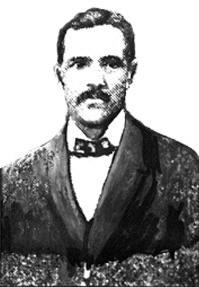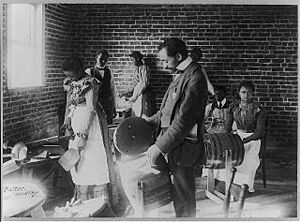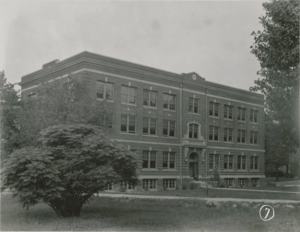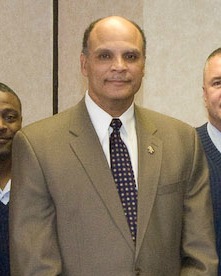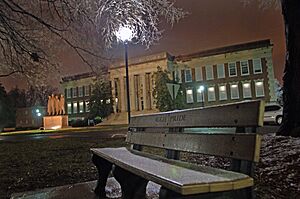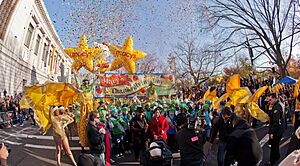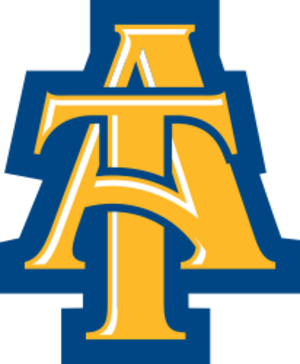- This page was last modified on 17 October 2025, at 10:18. Suggest an edit.
North Carolina A&T State University facts for kids
 |
|
|
Former name
|
Agricultural and Mechanical College for the Colored Race (1891–1915) Negro Agricultural and Technical College of North Carolina (1915–1957) Agricultural and Technical College of North Carolina (1957–1967) |
|---|---|
| Motto | Mens et Manus (Latin) |
|
Motto in English
|
"Mind and Hand" |
| Type | Public historically black land-grant research university |
| Established | March 9, 1891 |
|
Parent institution
|
University of North Carolina |
| Accreditation | SACS |
|
Academic affiliations
|
|
| Endowment | $202 million (2024) |
| Chancellor | James R. Martin II |
| Provost | Tonya Smith-Jackson |
|
Academic staff
|
759 |
| Students | 14,331 (fall 2024) |
| Postgraduates | 1,669 (fall 2023) |
| Location |
,
United States
36°04′31″N 79°46′25″W / 36.075352°N 79.773628°W |
| Campus | Large city, 200 acre (0.8 km2) main campus, 492 acre (1.99 km2) agricultural campus |
| Newspaper | The A&T Register |
| Colors | Blue and gold |
| Nickname | Aggies |
|
Sporting affiliations
|
|
| Mascot | Aggie the Bulldog |
 |
|
North Carolina Agricultural and Technical State University, often called North Carolina A&T or just A&T, is a large public university in Greensboro, North Carolina. It is a special kind of university known as a historically black college or university (HBCU). It is also a land-grant and research university.
A&T was started on March 9, 1891. It was first called the Agricultural and Mechanical College for the Colored Race. It was the second college created under a law called the Morrill Act of 1890. This law helped set up colleges that taught practical skills like farming and mechanics. A&T was the first college for people of color in North Carolina.
Today, North Carolina A&T is the largest HBCU in the United States, with over 14,000 students. Its College of Engineering trains more Black engineers than any other school in the country. The university also leads in graduating African Americans in agriculture, nursing, and journalism. Students and sports teams at A&T are known as "Aggies."
Contents
Discovering A&T's Past
How A&T Began
North Carolina A&T's story started in 1890. The U.S. Congress passed a law called the Second Morrill Act. This law said that states either had to allow all races into their colleges or create separate colleges for people of color. North Carolina chose to create a separate college.
So, on March 9, 1891, the Agricultural and Mechanical College for the Colored Race was officially started. It began in Raleigh, North Carolina, as part of Shaw University. The college's main goal was to teach practical farming and mechanical skills. It started with four teachers and 37 students.
In 1892, the college moved to Greensboro, North Carolina. The city donated land and money to help build the new campus. John Oliver Crosby became the first president.
Early Years and Growth
At first, A&T accepted both men and women of color. But in 1901, the school decided to only admit men. This rule changed back in 1928, allowing women to attend again. The first students graduated in 1899.
By 1904, the college had a 100-acre farm. This farm used the newest machines and helped provide food for the campus. In 1915, the college's name changed to Negro Agricultural and Technical College of North Carolina.
Expanding and Changing Names
In 1925, Ferdinand D. Bluford became the third president. The college joined a sports league called the Colored Intercollegiate Athletic Association. A&T's national alumni association, for former students, was created in 1926.
In 1939, A&T was allowed to offer master's degrees. The first master's degree was given out two years later.
The university grew its land in the 1940s and 1950s. In 1953, the School of Nursing was started. In 1957, the college's name changed again to the Agricultural and Technical College of North Carolina. That same year, the first white student was admitted.
A&T's Role in Civil Rights
On February 1, 1960, four brave freshmen from A&T helped start the Civil Rights Movement in the South. Ezell Blair (now Jibreel Khazan), Joseph McNeil, Franklin McCain, and David Richmond sat down at a "whites-only" lunch counter at Woolworth's. They asked for service, even though they knew they would be refused.
Their actions, known as the Greensboro sit-ins, inspired many others. Students from A&T and other colleges joined them in peaceful protests. By the end of July 1960, the "A&T Four" had helped change the rules at Woolworth's.
In 1967, the college was renamed North Carolina Agricultural and Technical State University.
Modern Era and Achievements
In 1971, A&T became part of the larger University of North Carolina system. Lewis C. Dowdy became the university's first chancellor.
In 2003, A&T teamed up with UNC Greensboro to create a Joint Millennial Campus. This campus focuses on helping the local economy grow. In 2008, A&T received a huge $18 million grant from the National Science Foundation for an Engineering Research Center. This was the first time an HBCU led such a big research project.
In 2009, Harold L. Martin became the twelfth chancellor. Under his leadership, A&T started a plan called "A&T Preeminence 2020." This plan aimed to make the university even better in areas like student numbers, research, and academic quality.
Because of this plan, A&T became the nation's largest HBCU in 2014 and has stayed that way. In 2018, it was named the top-ranked public HBCU by U.S. News & World Report. In 2020, MacKenzie Scott donated $45 million to A&T, the largest gift in the university's history.
Exploring the Campus
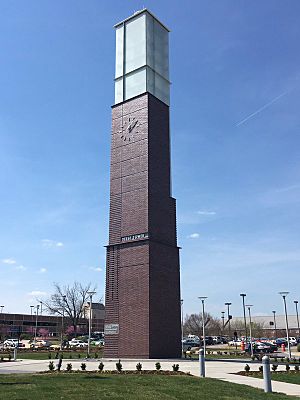
Deese Clock Tower is named for alumni Willie A. and Carrol C. Deese.
North Carolina A&T's main campus, called "Aggieland," is in Greensboro, North Carolina. The city is part of a larger area known as the Piedmont Triad.
The campus started with 14 acres of land in 1893. Today, the main campus is over 200 acres. It has 123 buildings, including academic halls, student dorms, and sports facilities. A&T also has a 492-acre working farm and two research parks.
A special part of the campus is the Agricultural and Technical College of North Carolina Historic District. This area has some of the university's oldest buildings, built in the Colonial Revival and Classical Revival styles.
New buildings have been added as the university has grown. These include a large Student Center and the Harold L. Martin Sr. Engineering Research and Innovation Complex.
University Art Galleries
Inside the James B. Dudley Memorial Building are the University Galleries. These galleries are home to two important collections: the Mattye Reed African Heritage Collection and the H. Clinton Taylor Collection.
The Reed African Heritage Collection started in the late 1960s. It has about 3,500 items, including art and crafts from over 35 African and Caribbean nations. The Taylor Collection shows art by African-American artists, as well as works by A&T students and teachers.
Caring for the Environment
A&T is committed to being environmentally friendly. Since 2003, the university has cut its energy use by 21 percent. This has saved a lot of money and energy.
The university uses many ways to save energy. They check buildings for ways to improve energy use, install energy-efficient lights, and use green building practices. For example, the Proctor School of Education Building has a green roof to help with stormwater and cooling. The Joint School of Nanoscience and Nanoengineering building is certified as a "LEED Gold" building, meaning it's very eco-friendly.
Because of these efforts, A&T was ranked 10th globally in a 2013 university sustainability ranking.
How A&T is Organized
North Carolina A&T is one of 16 public universities in the University of North Carolina system. This system is governed by a Board of Governors and led by a president.
University Leadership
Each UNC campus has a chancellor who leads the university. The chancellor is chosen by the Board of Governors. The current chancellor of N.C. A&T is James R. Martin II.
A&T also has its own Board of Trustees. This board helps guide the university and includes members chosen by the state and the governor. The student body president is also a member.
University Funding
In the 2017-2018 school year, A&T spent $288 million. The state of North Carolina provided $99 million. Tuition, fees, and other services brought in another $100 million. The university also received $95 million from grants and contracts, with a lot of that money going to help students with financial aid.
Academics at A&T
North Carolina A&T is approved by the Southern Association of Colleges and Schools (SACS). This means the university meets high standards for education.
A&T is known for being a top school for African American engineers. It produces the most Black engineers at the bachelor's level and is a leading producer at the master's and doctoral levels. The university is also famous for its agriculture programs. Its School of Agriculture and Environmental Sciences is the largest among HBCUs.
A&T has a special Honors College for high-achieving students. This college offers unique opportunities and benefits to about 1,000 students.
In the 2017–2018 school year, A&T awarded over 1,600 bachelor's degrees, 400 master's degrees, and 50 doctoral degrees.
Colleges and Schools
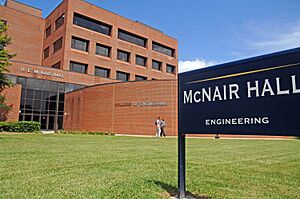
McNair Hall, named for A&T alumnus Ronald McNair, houses the College of Engineering.
A&T offers many different degree programs through its nine professional colleges. Students can earn bachelor's, master's, and doctoral degrees.
Some of the colleges include:
- College of Agriculture and Environmental Sciences
- College of Arts, Humanities and Social Sciences
- Willie A. Deese College of Business and Economics
- College of Education
- College of Engineering
- College of Health and Human Sciences
- College of Science and Technology
In 2020, the College of Business and Economics was named after Willie A. Deese, a former student and generous supporter of the university.
University Rankings
| USNWR National University | 231 (tie) |
|---|---|
| Washington Monthly National University | 150 |
North Carolina A&T is highly ranked. In 2020, U.S. News & World Report ranked A&T 6th among the best historically black universities in the nation. It was also one of the few HBCUs to be ranked among "national universities."
Money Magazine ranked A&T No. 3 for how much its graduates earn early in their careers among UNC System schools. In 2016, The Wall Street Journal named A&T a No. 2 public U.S. university for combining research and teaching.
Applying to A&T
| 2021 | 2020 | 2019 | 2018 | |
|---|---|---|---|---|
| Freshman Applicants | 21,528 | 16,366 | 15,083 | 11,089 |
| Admitted | 12,346 | 9,281 | 8,792 | 6,811 |
| % Admitted | 57.3 | 56.7 | 58.3 | 61.4 |
| Enrollment | 2,930 | 2,136 | 2,288 | 2,204 |
| Average GPA | 3.82 | 3.79 | 3.77 | 3.90 |
Getting into North Carolina A&T is considered "more selective." The university received over 30,000 applications for the Fall 2022 semester. A&T uses a rolling admissions program, meaning they review applications as they come in. Students who were accepted had an average GPA of 3.77.
Research at A&T
North Carolina A&T is known for its strong research programs. It is classified as a "Doctoral University – High research activity." In the 2018 fiscal year, the university conducted over $64 million in research. A&T ranks third in research funding among all University of North Carolina institutions. Most of this funding comes from federal agencies.
As a land-grant university, A&T focuses its research on many important areas. These include:
- Aerospace and transportation
- Biomedical research
- Biotechnology
- Computer science
- Energy and the environment
- Food science
- Human health
- Nanotechnology
The university has 20 research centers and works with government groups like the U.S. Department of Agriculture and the National Science Foundation.
Student Life at A&T
| Race and ethnicity | Total | ||
|---|---|---|---|
| Black | 85% |
|
|
| Other | 4% |
|
|
| Hispanic | 4% |
|
|
| White | 3% |
|
|
| Asian | 1% |
|
|
| Economic diversity | |||
| Low-income | 53% |
|
|
| Affluent | 47% |
|
|
In 2019, A&T had over 10,000 undergraduate students. About 43 percent were male and 57 percent were female. Most students (75 percent) were from North Carolina. As an HBCU, about 78 percent of students were African American.
Living on Campus
In 2019, about 40 percent of students lived in university dorms or apartments. Most dorms are for both male and female students. Some are just for females or just for males.
Students can also choose to live in "living-learning communities." These are special dorm areas with activities related to certain academic programs or interests. Each dorm has its own student government.
The newest dorms, called The Aggie Village, were built in 2005. They are named after the A&T Four students who started the sit-ins.
Student Organizations and Activities
A&T has over 120 student organizations. These include honor societies, clubs, performance groups, and fraternities and sororities. The Council of Presidents helps manage these groups.
The Blue and Gold Marching Machine is the university's famous marching band. It has over 200 members and has performed at national events like the Macy's Thanksgiving Day Parade.
Campus Media
The A&T Register is the student newspaper. It started in 1894 and is now published digitally, with print editions twice a semester. The newspaper has won awards for its news and opinion writing.
WNAA 90.1 FM is the campus radio station. It started in 1966 and became an FM station in 1979. Today, WNAA broadcasts 24 hours a day and can be heard far beyond Greensboro.
Students in the Journalism and Mass Communication department also run "The JOMC Journal," a multimedia news platform, and a TV studio.
Greek Life
A&T has a strong Greek system with 18 recognized fraternities and sororities. This includes all nine of the historically African American National Pan-Hellenic Council (NPHC) organizations. These groups focus on brotherhood, sisterhood, service, and leadership.
Special Events
A&T has many fun annual events. In early March, the university celebrates Founders' Day, marking the day the school was created.
Homecoming is a huge event, usually in October. It includes a football game, tailgating, concerts, pep rallies, step shows, a parade, and the crowning of Mister and Miss North Carolina A&T. Students and alumni call it the "Greatest Homecoming on Earth" (GHOE). It brings tens of thousands of people to Greensboro and boosts the local economy.
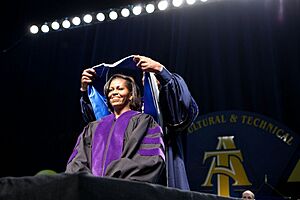
Then-First Lady of the United States Michelle Obama received an honorary doctoral degree from N.C. A&T in 2012.
Commencement ceremonies happen twice a year, in December and May. Many famous people have spoken at A&T graduations, including former First Lady of the United States, Michelle Obama.
A&T Sports: The Aggies
North Carolina A&T has 17 varsity sports teams. Eight are for men and nine for women. They compete in NCAA Division I. The teams are called the "Aggies," and their mascot is a bulldog. The name "Aggie" comes from the university's history as an agricultural school.
The Aggies have won over 60 conference championships in the MEAC and CIAA. The men's basketball team has won 16 conference titles. In 2013, they made history by winning their first Division I post-season game. The women's basketball team has also had great success, winning six MEAC regular season titles.
A&T is also strong in football and track and field. The football team has won eight MEAC championships and four Black college football national championships. The track and field program has produced many champions and All-Americans.
A&T has a big rivalry with North Carolina Central University. Their football teams first played each other in 1924.
High School Programs at A&T
A&T hosts two special high school programs on its campus:
STEM Early College
The STEM Early College at NC A&T State University is a top high school in North Carolina. It has about 200 students and is located in Smith and Price halls on the A&T campus. This school started in 2012 as a partnership with Guilford County Schools. Students can earn a high school diploma and up to two years of college credit from A&T.
A&T Four Middle College
The A&T Four Middle College at NC A&T State University is an all-boys high school program. It has about 200 students and is housed in Hodgin Hall. This school started in 2003, also with Guilford County Schools. It helps young men build confidence and look forward to a bright future. Students can take college classes while finishing their high school credits.
Both high school programs are competitive and require an application. They allow students to use A&T's facilities and get a head start on college.
Famous A&T Alumni
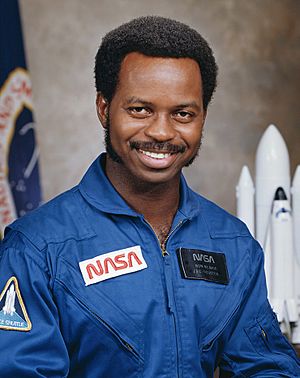
Ronald McNair, class of 1971, physicist and NASA astronaut.
North Carolina A&T has over 55,000 alumni (former students). Many have become famous and important leaders.
One well-known alumnus is NASA astronaut Ronald McNair. He graduated in 1971 with honors in engineering physics. He sadly passed away during the Space Shuttle Challenger explosion.
A&T graduates have also become leaders in education. For example, Harold L. Martin, the university's former chancellor, was the first alumnus to lead A&T. He was also the longest-serving HBCU leader in America.
Many alumni are important in public life. Michael S. Regan was the first Black man to lead the U.S. EPA. Alma Adams is a six-term U.S. Congresswoman. Rev. Jesse Jackson is a famous civil rights leader.
The A&T Four—Ezell Blair Jr., Franklin McCain, Joseph McNeil, and David Richmond—are also A&T alumni. Their brave actions helped change public accommodation laws across the country.
A&T graduates have also found success in business. Janice Bryant Howroyd founded the ACT-1 Group, a large human resources agency. Willie A. Deese, a former president at Merck, has a college named after him at A&T.
In media and entertainment, A&T alumni include film and TV producer Terrence J and Oscar-nominated filmmaker Kevin Wilson Jr..
In professional sports, A&T has produced many stars. Al Attles was one of the first African American professional basketball coaches in the NBA. Elvin Bethea is in the Pro Football Hall of Fame. Brad Holmes, a former Aggies defensive tackle, is now the General Manager of the Detroit Lions.

